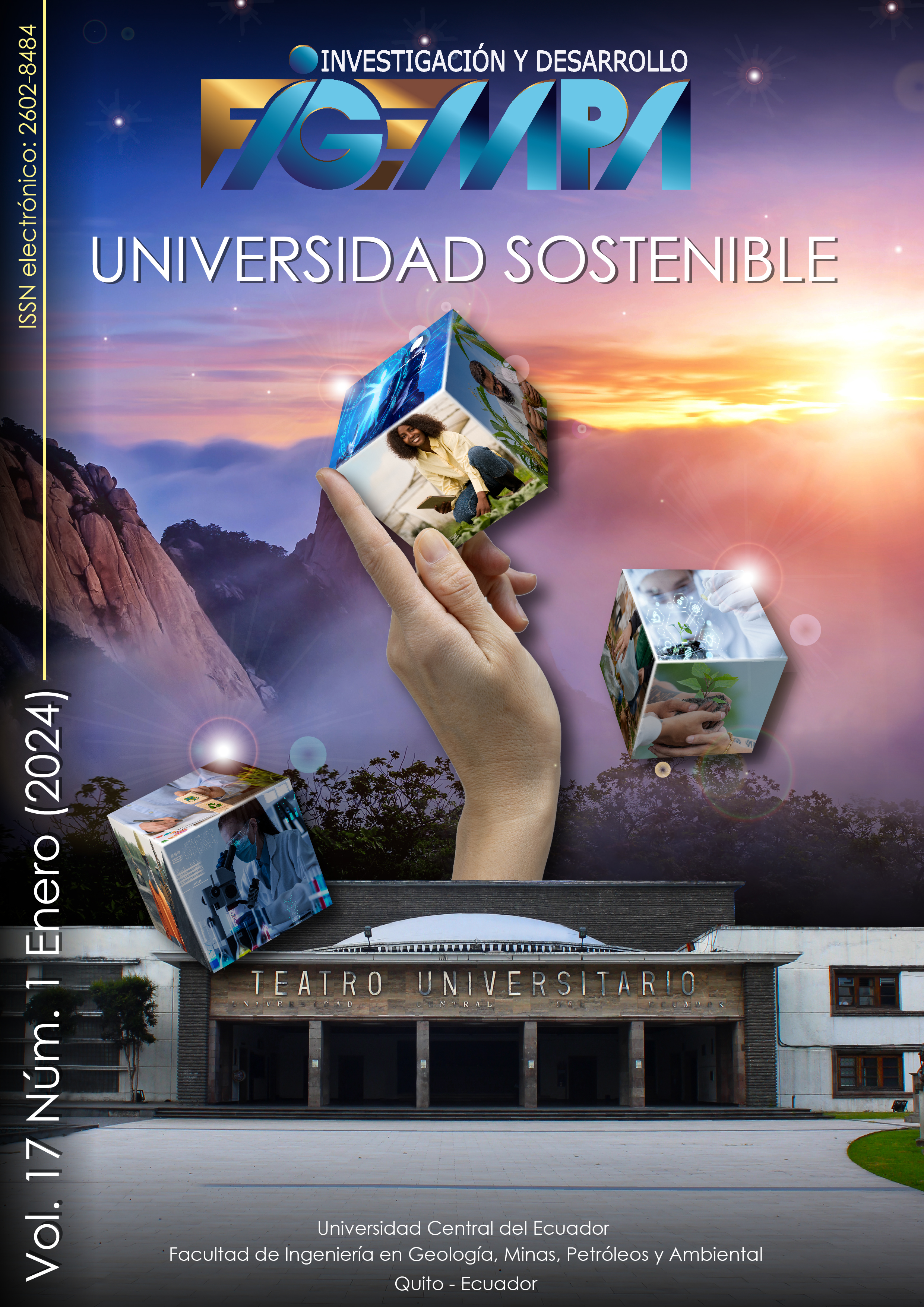Relation between specific consumption/advance, in underground mining operations MAPE, study case Ecuador
Main Article Content
Abstract
In Ecuador, Artisanal and Small-Scale Mining, MAPE, is an activity of national relevance. Historically there are three provinces with great potential and mining tradition, which are: El Oro, Zamora Chinchipe and Azuay. In this sense, in the province of El Oro, a large percentage of the economically active population depends directly or indirectly on the exploitation of highly profitable minerals. The key aspects for the development of underground operations of the MAPE regime are the drilling and blasting activities, where there is a great opportunity for improvement, efficiently managing the design of the grid, the execution of the drilling, the amount of explosive and the way it is charged, which are the factors that define the result of the blasting; same that is valued in function of the depth of cut or advance and of the uniformity of the structure of the section. For the development of this research, the baseline survey was carried out through technical visits to the study sector (Zaruma - Portovelo mining district), where traditional work procedures were observed, and then, based on the experimental method, technical variations were made in regarding the firing diagram, specific charge, specific perforation and type of explosive. These traditional (empirical) procedures, based on the driller's field experience, cause, among other things, the inefficiency of the advance, problems to maintain the dimensions of the section, over breaking of the working fronts, and one of the most relevant factors, the insecurity of the personnel who in many cases remain inside the mine for more than 10 hours.The main results show that the best tests were those that used the emulsion/ANFO (Amonium Nitrate Fuel Oil) combination, obtaining an advance percentage of approximately 95%, considered optimal within the operation. It was also evidenced that the Ammonium Nitrate commonly used in ASM needs a specific charge of greater power to meet the objective of the blasting.
Downloads
Metrics
Article Details

This work is licensed under a Creative Commons Attribution 4.0 International License.
References
Almeida, M. D. (2019) Estudio de caso sobre la gobernanza del sector minero en el Ecuador, in Documentos de Proyectos (LC/TS.2019/56). Santiago: Comisión Económica para América Latina y el Caribe (CEPAL), p. 117. http://hdl.handle.net/11362/44876.
Barajas Pinzó, Ó. M. (2021) Consideraciones de seguridad con nitrato de amonio. Bogotá, D.C., Colombia: Consejo Colombiano de Seguridad. https://ccs.org.co/portfolio/consideraciones-de-seguridad-con-nitrato-de-amonio/.
Bernaola, J., Castilla, J. y Herrera, J. (2013) Perforación y voladura de rocas en minería. Universidad Politécnica de Madrid.
Bustamante, T. y Lara Ponce, R. (2010) El Dorado o la caja de Pandora : matices para pensar la minería en Ecuador. Ecuador: Flacso.
Cardu, M. y Seccatore, J. (2016) Cuantificación de la dificultad de excavación de túneles mediante perforación y voladura. Tunnelling and Underground Space Technology, 60, pp. 178–182. Doi: 10.1016/j.tust.2016.08.010.
Department of Mines Industry Regulation and Safety (2021) Safe storage of solid ammonium nitrate – code of practice, in Department of Mines Industry Regulation and Safety (ed.). Western Australia, p. 35.
Díaz-Martínez, J. C., Guarín-Aragón, M. A. y Jiménez-Builes, J. A. (2012) Análisis y Diseño de la Operación de Perforación y Voladuras en Minería de Superficie Empleando el Enfoque de la Programación Estructurada. Boletín de Ciencias de la Tierra, 32(32), pp. 15–22. http://www.scielo.org.co/pdf/bcdt/n32/n32a02.
EXSA (2000) Manual práctico de voladura. Lima - Perú: Departamento Técnico Exsa S.A., p. 81. https://www.udocz.com/apuntes/86082/manual-practico-de-voladura-exsa.
EXSA (2019) Manual práctico de voladura EXSA, 5ta edicion. Lima - Perú. https://www.minerosunsa.com/2019/10/manual-practico-de-voladura-exsa-5ta.html.
García, P. J. M. (2021) Malla de Perforación Subterránea. Cerro de Pasco, Perú: Universidad Nacional Daniel Alcides Carrión, UNDAC, p. 15.
Holmberg, R. y Persson, P. (1980) Diseño de patrones de voladura del perímetro del túnel para evitar daños en las rocas, Trans. Inst. mín. Metall. Londres, pp. A37–A40.
Ingeopres (2011) Perforación y Voladuras. IGP, 206, p. 52.
López Aquino, J. J. (2019) Voladura de rocas con anfo para optimizar avances en labores subterráneas de Compañía Minera Casapalca S.A. Universidad Nacional del Centro del Perú.
López Jimeno, C. (2016) Diseño de Voladuras en Túneles y Galerías. Madrid, España, p. 6.
Oliva González, A. O., Ruiz Pozo, A. F. y Gallardo Amaya, R. J. (2018) Inestabilidad del terreno en zonas de actividad minera: caso ciudad de Zaruma, Ecuador. Redes de Ingeniería, 8(1), pp. 69–81.
Paredes Pozo, D. C. (2013) ¿Después de la minería que? Análisis del impacto socioeconómico y ambiental de la minería. Caso South American Development Company (SADCO - CIMA), Portovelo y Zaruma - El Oro - Ecuador. FLACSO ANDES. http://repositorio.flacsoandes.edu.ec/handle/10469/5943.
Quispe Gaspar, J. E. (2014) El modelo Matematico de Holmberg como alternativa en el diseño de mallas de perforación para optimizar las operaciones de voladura subterránea en la Cia. Minera Casapalca S.A. Universidad Nacional de Huancavelica.
Registro Oficial Órgano del Gobierno del Ecuador No.162 (2012) Código del Trabajo. Quito-Ecuador: Talleres Gráficos Editora Nacional, p. 159. www.lexis.com.ec.
Risks, R. y Nitrate, A. (2020) Amat insights. (01), pp. 1–26.
Rojas-Villacís, C. A. y Zúñiga-Arrobo, C. A. (2022) Análisis de la actividad de carguío y transporte en minería artesanal en “El Guayabo”, Ecuador. FIGEMPA: Investigación y Desarrollo, 14(2), pp. 1–12. doi: 10.29166/revfig.v14i2.3854.
Seccatore, J. y Cardú, M. (2017) Sobre la influencia de los ángulos de rotura en la eficiencia de tracción de tunelización por perforación y voladura. Asociación Chilena de Ingenieros Explosivistas XII. Santiago, Chile.
Seccatore, J., González, P. y Herrera, M. (2020) Peculiaridades de la perforación y voladura en minas subterráneas de pequeña escala. Mineração, 73(3), pp. 387–394.
Ulloa, W. (2023) Relación de las regalías mineras y el desarrollo del cantón Portovelo en Ecuador. Estudios de la Gestión: Revista Internacional de Administración, 13(13), pp. 149–172. doi: 10.32719/25506641.2023.13.7

